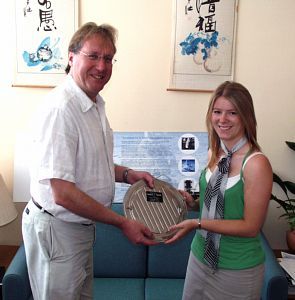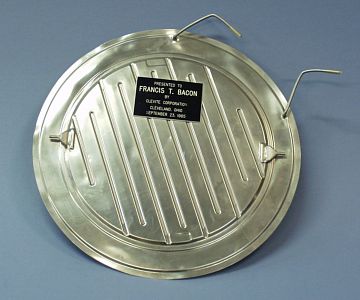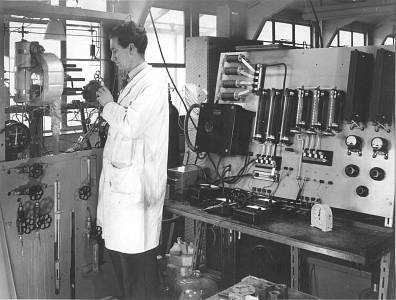 Working in the Department of Chemical Engineering in the 1950's, F.T. (Tom) Bacon made the crucial discoveries which enabled the highly efficient fuel cells used in the Apollo spacecraft to be built.
Working in the Department of Chemical Engineering in the 1950's, F.T. (Tom) Bacon made the crucial discoveries which enabled the highly efficient fuel cells used in the Apollo spacecraft to be built.
The Department has now donated one of the fuel cell electrodes to the Whipple Museum of the History of Science and the photograph shows Head of Department Professor Howard Chase handing the artefact to Lisa Newble, Collections Manager at the Whipple.
The fuel cell electrode shown was presented to F.T. Bacon by Clevite Corporation of Cleveland, Ohio on September 23, 1965 and was given to the Department by his family after his death in 1992. After several years on display here, the Department decided to donate it to the Whipple so that it can be preserved and displayed to the general public. The Whipple Museum's collection includes scientific instruments and other material related to the history of science. It forms part of the Department of History and Philosophy of Science, University of Cambridge.
 A fuel cell was first demonstrated by Sir William Grove M.A., F.R.S. in 1839, but his invention lay dormant for about 120 years, until it was revived by Francis Bacon F.R.S., who provided NASA with their first "Alkaline Fuel Cell". Fuel cells were used to provide power and water during manned space flights, such as the Apollo missions to the moon. They are also used on the International Space Station and the Space Shuttles.
A fuel cell was first demonstrated by Sir William Grove M.A., F.R.S. in 1839, but his invention lay dormant for about 120 years, until it was revived by Francis Bacon F.R.S., who provided NASA with their first "Alkaline Fuel Cell". Fuel cells were used to provide power and water during manned space flights, such as the Apollo missions to the moon. They are also used on the International Space Station and the Space Shuttles.
The Bacon fuel cell is also to be featured in the Mercedes Benz visitor and experience centre which is to open in Surrey in Autumn, 2006. A multimedia installation including information on fuel cells will be in the educational section on automotive technologies called MB World.
The Bacon fuel cell
Unlike heat engines whose efficiency is subject to the Carnot limitation, a fuel cell, which is a primary voltaic cell, can in principal release all of the free energy of a chemical reaction as electricity. In practice efficiencies in excess of 70% are attainable. Bacon concentrated on developing a hydrogen-oxygen cell with alkaline (KOH) electrolyte operating under pressure at about 200oC using non-precious metals. The first problem to be overcome was to establish a stable interface between gas, electrolyte and electrode; this was finally achieved by means of a biporous structure. A small positive differential pressure was maintained between gas and electrolyte. On the gas side of the sintered nickel electrode coarse pores allowed to displace the electrolyte which was retained by fine pores by surface tension. Thus an interface was established within the nickel electrode.
 Although these electrodes made it possible to build a fuel cell, rapid deterioration of the oxygen electrode occurred. The problem was finally solved by oxidising the oxygen electrodes in air when coated with Lithium hydroxide solution. This treatment lead to the formation of a black semiconducting nickel oxide layer which was stable under operating conditions. Another vital observation was that by using very high concentrations of KOH, the oxygen electrode performance and hence cell efficiency were greatly improved. This made the Bacon cell superior to alternatives.
Although these electrodes made it possible to build a fuel cell, rapid deterioration of the oxygen electrode occurred. The problem was finally solved by oxidising the oxygen electrodes in air when coated with Lithium hydroxide solution. This treatment lead to the formation of a black semiconducting nickel oxide layer which was stable under operating conditions. Another vital observation was that by using very high concentrations of KOH, the oxygen electrode performance and hence cell efficiency were greatly improved. This made the Bacon cell superior to alternatives.
Work in the Department which had been sponsored by the Electrical Research Association and the Ministry of Fuel and Power culminated in a six-cell 5 inch diameter battery operating at 200oC and 400psi achieving individual cell EMFs of 0.8V at 230mA/sq cm. Subsequently sponsored by NRDC the work was moved to Marshall of Cambridge where a 40 cell 10 inch diameter hydrogen-oxygen battery producing some 5 kW of power, was built and demonstrated in 1959.
At this time the proposed Apollo moon probe was designed with hydrogen and oxygen on board for propulsion and life support. The fuel cell was an ideal source of on-board electrical power with the additional advantage that the exhaust water could be used both for drinking by the crew and humidification of the capsule's atmosphere. Because of its high efficiency, the Bacon cell was licensed by the Pratt and Whitney Division of United Aircraft and used in a successful bid to NASA for a $100 million proposal to build the power source for Apollo.
The success of the Apollo mission is history and on a subsequent visit made by Bacon to the United States, President Richard Nixon put his arm around Tom's shoulders and said, "Tom, without you, we wouldn't have gotten to the moon".
Further information
Papers on the development of the Fuel Cell, 1940-90, are kept by the Churchill College archives
Francis Thomas (Tom) Bacon (1904-1992)
Whipple Museum of the History of Science
Key principles and processes occurring within a range of different fuel cells

